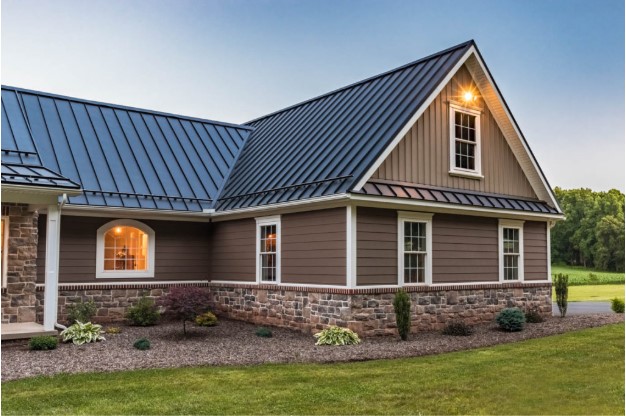Metal roofs are becoming increasingly popular due to their durability, longevity, and aesthetic appeal. However, one concern with metal roofing is heat transfer. Metal roofs can absorb and retain heat, especially during hot summer months, causing your home to become warmer and increasing energy costs. Fortunately, there are several ways to prevent heat transfer in metal roofs, helping to maintain a cooler indoor environment and improve energy efficiency. Here’s how you can keep your metal roof from overheating.
1. Choose Reflective Coatings
One of the most effective ways to prevent heat transfer in metal roofs is by applying reflective coatings. These coatings are designed to reflect sunlight away from the roof, reducing heat absorption. Many modern reflective coatings contain materials like acrylic or silicone that can block the sun’s rays and help maintain cooler temperatures in your home. These coatings are typically applied to the roof’s surface and can be customized to fit your specific roofing material.
Reflective coatings not only reduce heat but also protect your roof from UV damage, extending its lifespan. If you’re in a region with extreme heat, consider consulting with a roofing professional about the best reflective coatings for your metal roof.
2. Install a Radiant Barrier
A radiant barrier is a type of insulation installed underneath the metal roof. This barrier reflects heat away from your home, preventing the sun’s heat from penetrating your living space. It works by reducing the amount of thermal energy transferred from the roof to the attic or ceiling below.
Radiant barriers are particularly effective when installed in combination with other insulation methods. They are typically made of reflective aluminum foil and can be installed in both new builds and existing homes. The barrier creates an effective thermal resistance layer, reducing cooling costs in warmer months and keeping your home more comfortable.
3. Proper Insulation
Proper insulation is crucial for maintaining energy efficiency and preventing heat transfer in metal roofs. Insulating the roof properly can help maintain a stable indoor temperature, ensuring that heat doesn’t escape during winter and doesn’t enter during the summer. Several types of insulation can be used with metal roofs, including fiberglass, foam, and spray foam insulation.
By installing insulation, you’re creating a buffer between the metal roof and the interior of your home. This can help prevent heat from being absorbed directly into your living space and also reduce the load on your cooling system.
4. Ventilation is Key
Proper ventilation in your attic or roof space can help mitigate heat buildup under a metal roof. Without ventilation, heat can get trapped in the attic, raising temperatures in the living areas below. Installing ridge vents, soffit vents, or gable vents helps to create a flow of air that allows hot air to escape and cooler air to enter, promoting natural cooling.
Ventilation works hand-in-hand with insulation and reflective coatings, helping to keep your home cooler in the summer and reducing the need for air conditioning. With the right ventilation system, your attic will be cooler, and your home’s indoor temperature will be more comfortable.
5. Opt for Lighter Colored Metal Roofing
The color of your metal roof plays a significant role in how much heat it absorbs. Lighter-colored metal roofing materials, such as white, light gray, or beige, reflect more sunlight than darker-colored ones, which absorb heat. If you’re building a new home or replacing your roof, consider choosing a lighter-colored metal roofing option to minimize heat absorption and increase energy efficiency.
If you already have a darker metal roof, it might be possible to apply a lighter reflective coating to reduce heat absorption and improve the overall energy efficiency of your roof.
6. Install a Cool Roof System
Cool roofs are designed to reflect more sunlight and absorb less heat compared to traditional roofs. A cool metal roof system uses specially designed reflective materials to reduce heat transfer. These systems are particularly beneficial for homes in hot climates, as they can lower cooling costs and improve the comfort of your living space.
Cool roofing systems are available in various colors, materials, and styles, allowing you to choose one that fits the aesthetic of your home while maximizing energy efficiency.
Contact Us for Professional Roof Insulation Solutions
If you want to prevent heat transfer in your metal roof and improve your home’s energy efficiency, we can help. At NextDoor Exterior Solutions, we specialize in metal roofing solutions, including reflective coatings, insulation installation, and ventilation systems that can keep your home cool all year round. Contact us today for a consultation and let us help you create a more energy-efficient home!
This post was written by a professional at NextDoor Exterior Solutions. Looking for reliable roofing contractors in Clearwater, FL and its surrounding areas? Look no further than NextDoor Exterior Solutions! Our experienced team of roofers is dedicated to providing roof replacement Palmetto fl. Whether you need roof repair, replacement, or installation, we’ve got you covered. Plus, as a solar energy company near you, we can even help you save money on your energy bills with our expert solar panel installation services. The mission and values of our company allow us to always demonstrate the full potential of our professionalism. You can rely on us for quality. Don’t settle for subpar roofing services – choose NextDoor Exterior Solutions and experience the difference. Contact us today!

